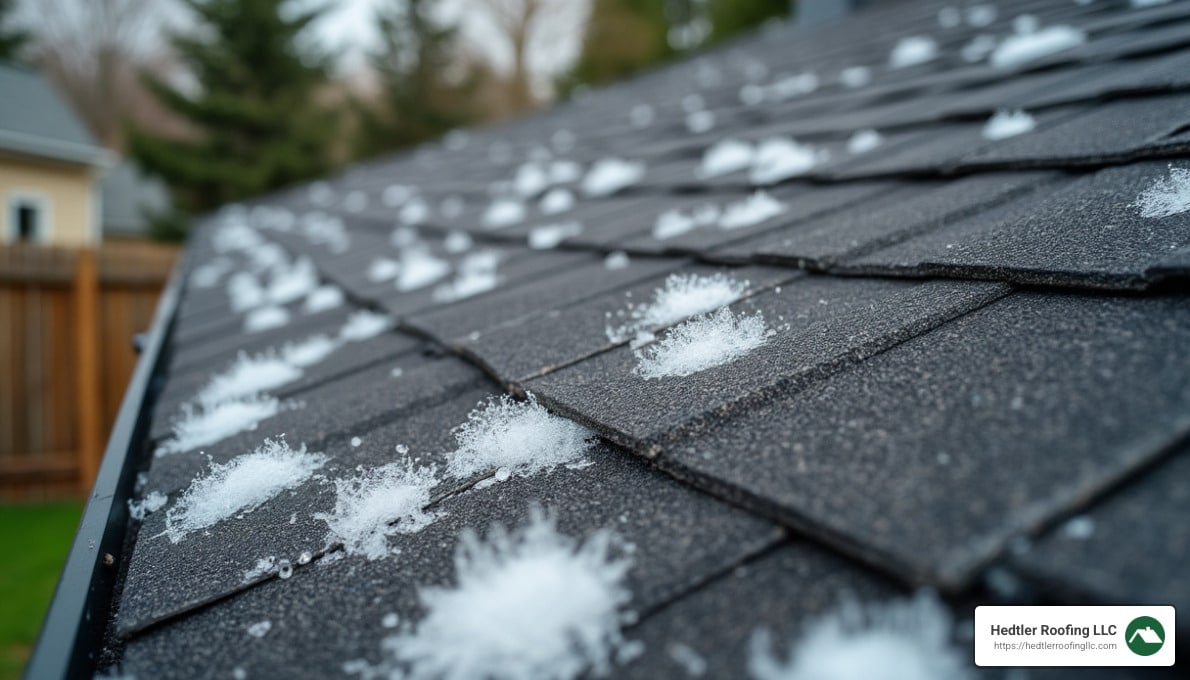Hail Damage Roof Inspection: Top 5 Expert Tips 2025
Hail damage roof inspection is crucial for homeowners in Massachusetts, where unpredictable New England weather can wreak havoc on roofs. If you’re concerned about hail damage or need a quick guide, here’s what you need to know:
- What to Look For: Check for dents in metal components like roof vents and flashing. Look for missing shingles and granule loss.
- Why It’s Important: Hail damage might not be visible from the ground. Ignoring it can lead to costly repairs.
- Steps to Take: Hire a professional for a thorough inspection. Document the damage and consult your insurance for possible claims.
Hailstorms can cause significant damage, affecting the longevity and safety of your roof. Therefore, a timely inspection ensures early detection and prevents further issues.
Welcome! I’m Jason Hedtler, owner of Roof Experts in Bellingham, MA. With over 20 years of experience in hail damage roof inspection, I’ve helped countless Massachusetts homeowners protect their properties from weather-related damages. My goal is to provide you with expert insights and reliable service in all aspects of roofing.

Common hail damage roof inspection vocab:
– roof inspection checklist
– roof inspection for insurance
– how to inspect a roof
Understanding Hail Damage
Hail might seem like just ice falling from the sky, but it can pack a punch. Let’s break down how hail forms, its size, and the potential damage it can cause to your roof.
Hail Formation
Hailstones are born in thunderstorm clouds. When updrafts—strong winds pushing upward—carry dirt and dust high into the clouds, super-cooled water droplets latch onto these particles. As the updrafts weaken, the tiny ice balls fall and rise again, picking up more layers of ice each time. Eventually, these hailstones become too heavy to be supported by the wind and plummet to the ground.
Hail Size
Hailstones can vary greatly in size, from tiny pebbles to larger-than-golf-ball giants. The size largely depends on how many trips the stone makes through the storm cloud layers. The bigger the stone, the more potential for damage.
In Massachusetts, where weather can be unpredictable, hail can reach sizes that are capable of causing serious harm to roofs.
Damage Potential
The damage potential of hailstones is not just about size. Density and speed also play critical roles. A smaller, denser hailstone traveling at high speeds can cause as much damage as a larger, less dense one.

Hail can dent gutters, crack shingles, and strip away the granules that protect your roof from UV rays. This kind of damage can compromise the integrity of your roof, leading to leaks and structural issues if not addressed promptly.
In Massachusetts, hail damage is a real concern for homeowners. Understanding how hail forms and its potential to damage your roof is the first step in protecting your home. Regular hail damage roof inspections can help catch issues early, saving you money and headaches in the long run.
Signs of Hail Damage on Your Roof
Hailstorms can leave behind more than just a wet yard. They can cause significant damage to your roof, which isn’t always easy to spot. Let’s explore the key signs of hail damage you should look out for: dented gutters, damaged shingles, and granule loss.
Dented Gutters
One of the easiest places to spot hail damage is your gutters. After a storm, check for dents or dings. These are telltale signs that hail has struck. Dented gutters not only look unsightly but can also affect water flow, leading to potential water damage around your home.
Damaged Shingles
Hail can be brutal on shingles. Damaged shingles might appear cracked, torn, or even missing. Sometimes, the damage is subtle, like small bruises or circular marks. These marks are where the hail has hit and crushed the shingle surface, potentially allowing water to seep in over time.

Granule Loss
Granules are the tiny, sand-like particles on the surface of asphalt shingles. They protect your roof from UV rays. After a hailstorm, check your gutters and downspouts for an accumulation of these granules. Granule loss is a sign that your shingles have been battered by hail. Without these granules, shingles can deteriorate faster, leading to leaks and other issues.
In Massachusetts, where hailstorms are not uncommon, it’s crucial to be vigilant about these signs. Regular hail damage roof inspections can help identify and address these issues before they lead to more severe problems. Early detection is key to maintaining the integrity of your roof and protecting your home.
Next, we’ll explore the inspection process and share some useful safety tips to keep in mind.
Hail Damage Roof Inspection
Inspecting your roof after a hailstorm is crucial to catch any damage early. Here’s how the process works and some tips to ensure safety and proper documentation.
Inspection Process
A hail damage roof inspection typically starts with a thorough visual check. Professionals look for signs like dented metal vents, missing shingles, and areas where granules have been stripped away. They might use chalk to highlight hail impacts, making it easier to document the damage.
Step-by-step inspection:
- Visual Inspection: Begin by examining the roof from the ground with binoculars for visible damage.
- Up-Close Inspection: Carefully inspect the roof surface, checking for cracked or missing shingles and dented vents.
- Gutter Check: Look inside gutters for granule buildup, indicating shingle damage.
- Photographic Evidence: Take clear photos of any damage for documentation.
Safety Tips
Roof inspections can be risky, so safety is a priority.
- Use Proper Equipment: Always use a sturdy ladder and wear non-slip shoes.
- Avoid Slippery Surfaces: Only inspect when the roof is dry to prevent slips.
- Know Your Limits: If you’re not comfortable or it’s too dangerous, call a professional.
Documentation
Proper documentation is vital for insurance claims. After marking and photographing the damage, compile a report detailing all findings. Include:
- Photos and Videos: Capture clear images of all affected areas.
- Detailed Descriptions: Note the type and extent of damage.
- Estimate of Repairs: Provide an estimate for repair or replacement costs.
Having this documentation ready can significantly speed up the insurance claim process. As seen in a case study from Massachusetts, detailed reports from Roof Experts have helped homeowners secure full roof replacements through their insurance.
By following these steps, you ensure a thorough and safe inspection process, paving the way for effective repairs and a strong insurance claim. Next, we’ll discuss how to steer the insurance claim process for hail damage.
How to File an Insurance Claim for Hail Damage
Once you’ve completed your hail damage roof inspection and documented the findings, it’s time to steer the insurance claim process. This can seem daunting, but with the right steps, you can make it smoother.
The Insurance Process
- Contact Your Insurance Company: Start by notifying your homeowners insurance provider about the hail damage. They will guide you on how to proceed and what to expect.
- Submit Your Documentation: Provide all the evidence gathered during your inspection. This includes photos, videos, and a detailed report of the damage. The more comprehensive your documentation, the better.
- Schedule an Adjuster Visit: Your insurance company will send an adjuster to assess the damage. It’s crucial to have your roofing contractor present during this visit. They can advocate for you and ensure nothing is missed.
Claim Documentation
Proper documentation is your strongest asset when filing a claim. Here’s what you should include:
- Visual Evidence: Clear photos and videos of all damage, including detailed shots of dented vents, missing shingles, and granule loss.
- Inspection Report: A thorough report from your roofing contractor, detailing the damage and estimated repair costs.
- Receipts and Invoices: If you’ve already had temporary repairs done, include any receipts or invoices.
Adjuster’s Role
The adjuster is a key figure in the insurance claim process. Their job is to evaluate the damage and determine the extent of coverage. Here’s how to handle their visit:
- Be Present: Ensure either you or your roofing contractor is there during the adjuster’s inspection. This allows you to provide insights and answer any questions.
- Ask Questions: Don’t hesitate to ask the adjuster about their findings and how they arrived at their conclusions.
- Request a Copy: After the inspection, ask for a copy of the adjuster’s report for your records.
Filing an insurance claim for hail damage doesn’t have to be overwhelming. By being prepared and informed, you can steer the process with confidence. In the next section, we’ll address some of the most frequently asked questions about hail damage roof inspections.
Frequently Asked Questions about Hail Damage Roof Inspection
How do you know if your roof is damaged by hail?
Identifying hail damage on your roof can be tricky, but there are clear signs to watch for. Dented gutters, damaged shingles, and granule loss are common indicators. After a storm, check for dents in metal surfaces like gutters and vents. If you notice excessive granules in your gutters, it could mean the shingles have been compromised.
Additionally, look for visible damage like missing or cracked shingles. If you’re unsure, it’s best to have a professional conduct a hail damage roof inspection to confirm the extent of the damage.
What size hail causes roof damage?
The size of hailstones plays a crucial role in the potential for roof damage. Generally, hailstones 1 inch or larger can cause significant damage to most roofing materials. However, even smaller hailstones can lead to damage if accompanied by strong winds. The damage threshold varies based on your roof’s material and age. For instance, older shingles or those made from softer materials may be more vulnerable to smaller hail.
What does hail damage do to shingles?
Hail damage to shingles can compromise their integrity and lead to exposure risks. When hail strikes, it can knock off the protective granules on shingles, leading to granule loss. This exposes the underlying layers to UV rays, accelerating wear and increasing the risk of leaks.
Moreover, hail can cause cracks or tears in shingles, allowing water to seep through and damage the roof’s structure. Over time, this can lead to costly repairs or even a full roof replacement. Regular inspections and timely repairs are essential to protect your home from further damage.
Conclusion
For Massachusetts homeowners, safeguarding your roof against hail damage is crucial. At Roof Experts, we understand the importance of a thorough hail damage roof inspection to ensure your roof remains in top shape after a storm.
Our team, with over 20 years of experience, is committed to providing high-quality inspections and services. We know that hail can be deceptive, causing damage that isn’t always visible to the untrained eye. That’s why professional inspections are essential. We use our expertise to identify even the smallest signs of damage, helping you take action before minor issues become major problems.
Choosing a professional inspection with Roof Experts not only protects your home but also your peace of mind. We document every finding carefully, providing you with a detailed report. This documentation is vital, especially if you need to file an insurance claim.
Massachusetts weather can be unpredictable, but with our help, you can be prepared. Trust us to keep your roof—and your home—safe from the elements.
For more information on our inspection services, visit our Roof Inspections page. Let us help you ensure your roof survives the storm.


